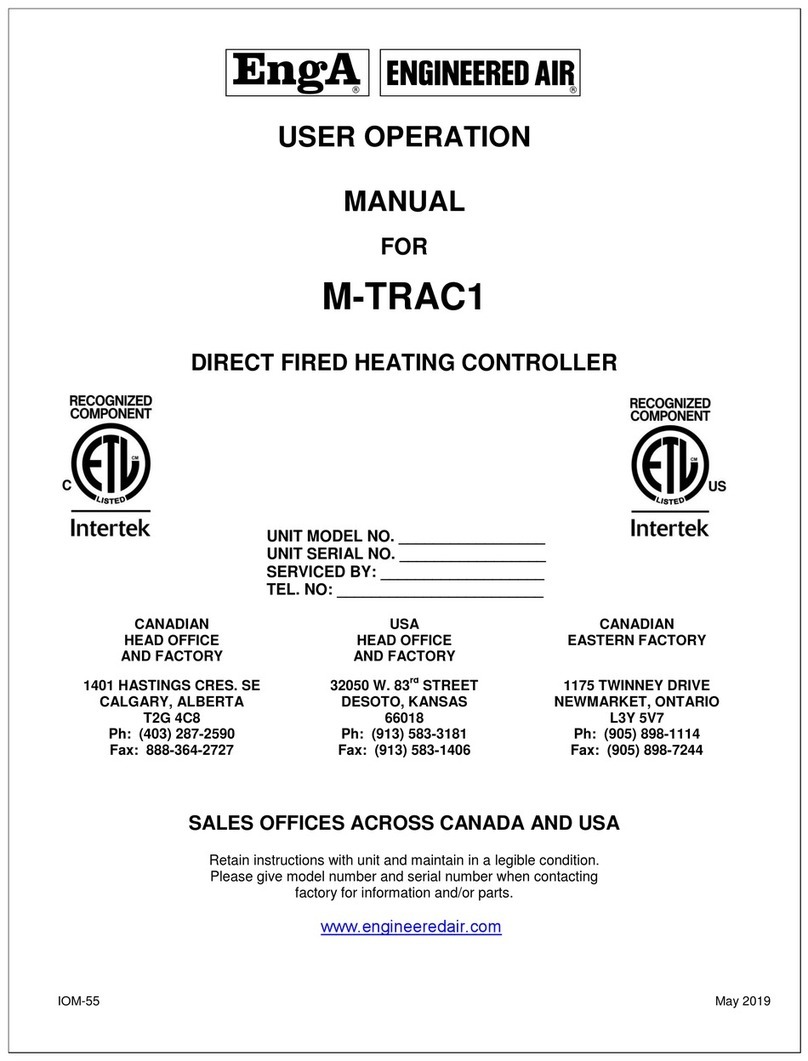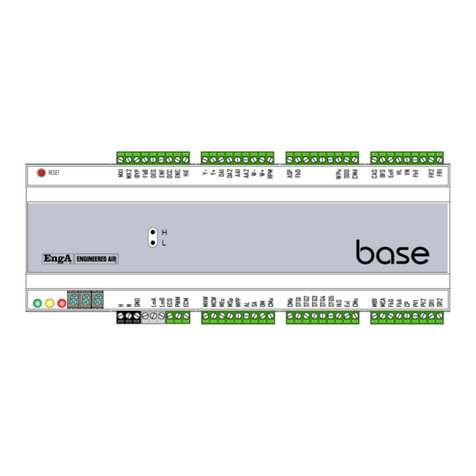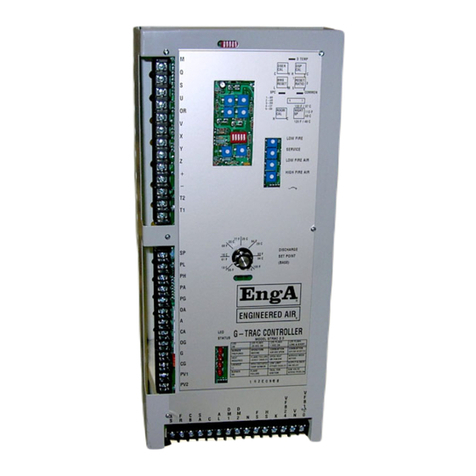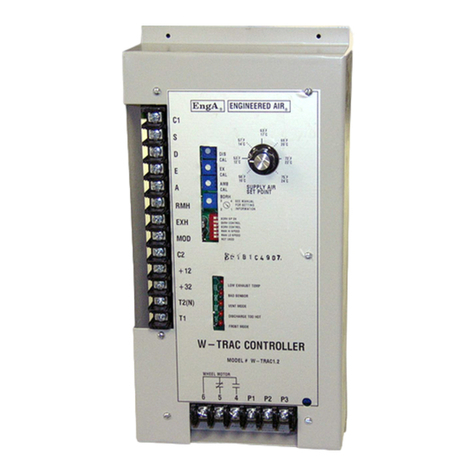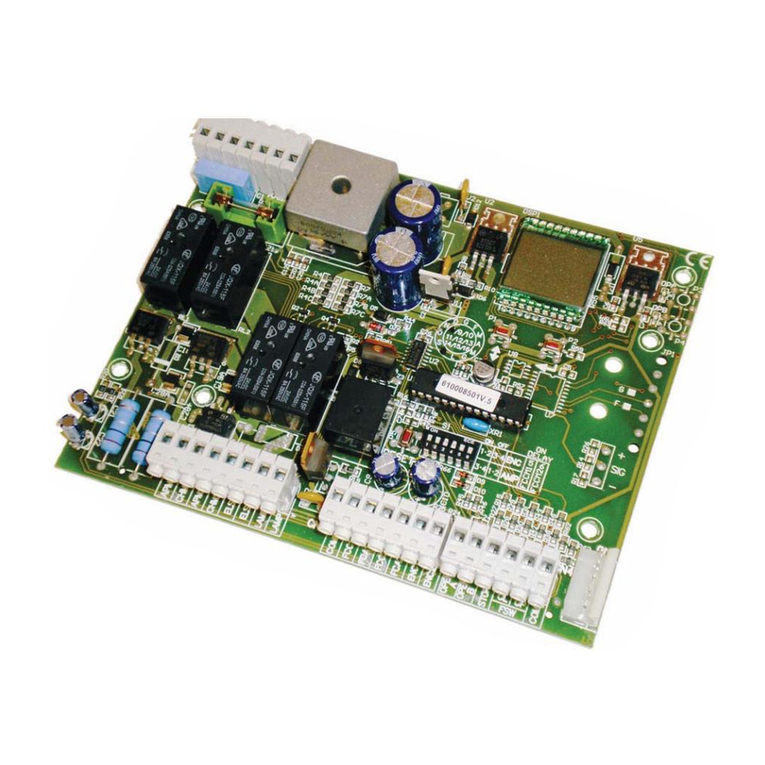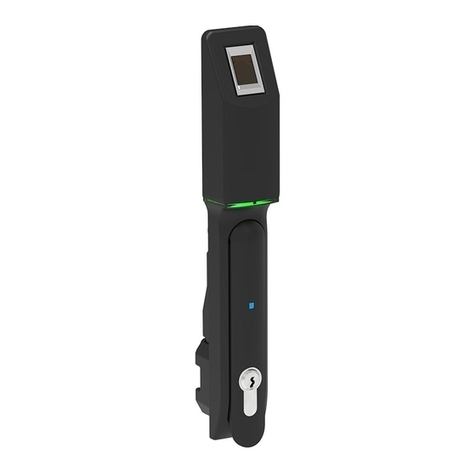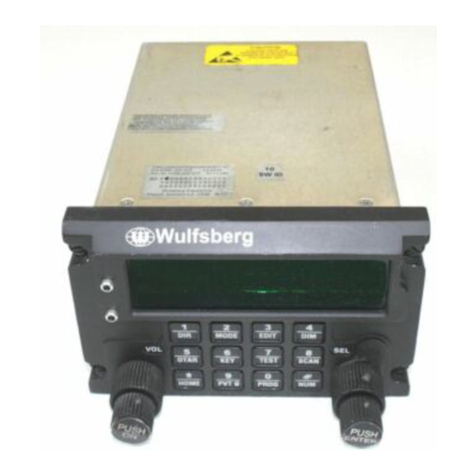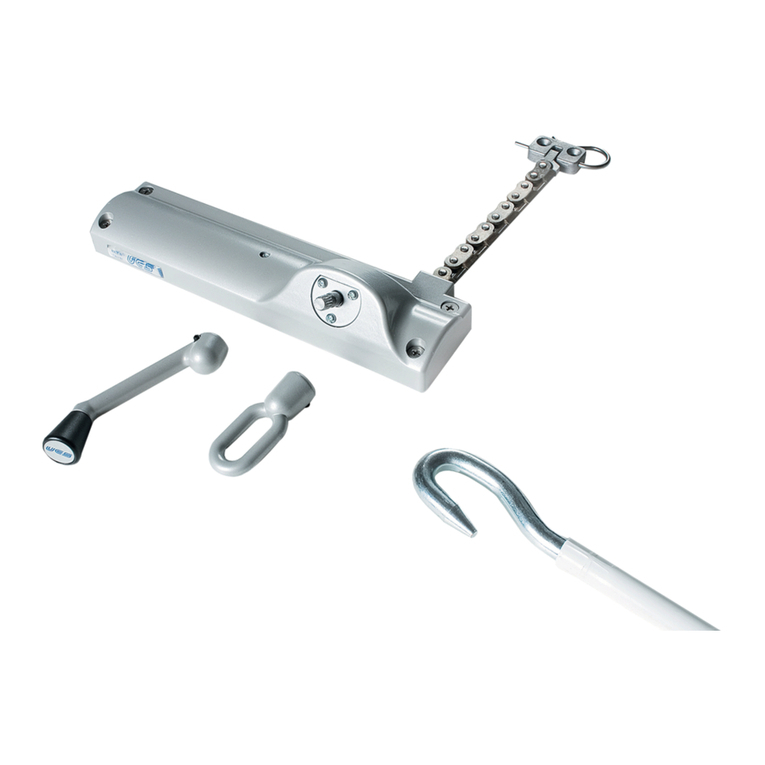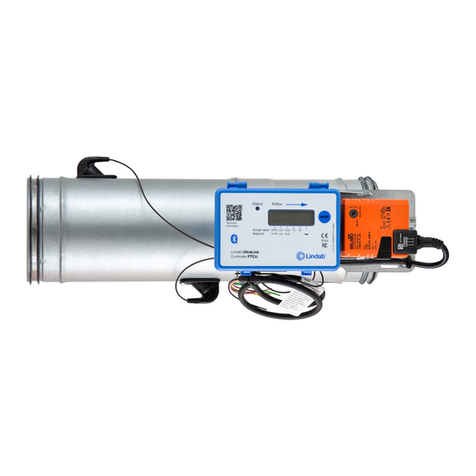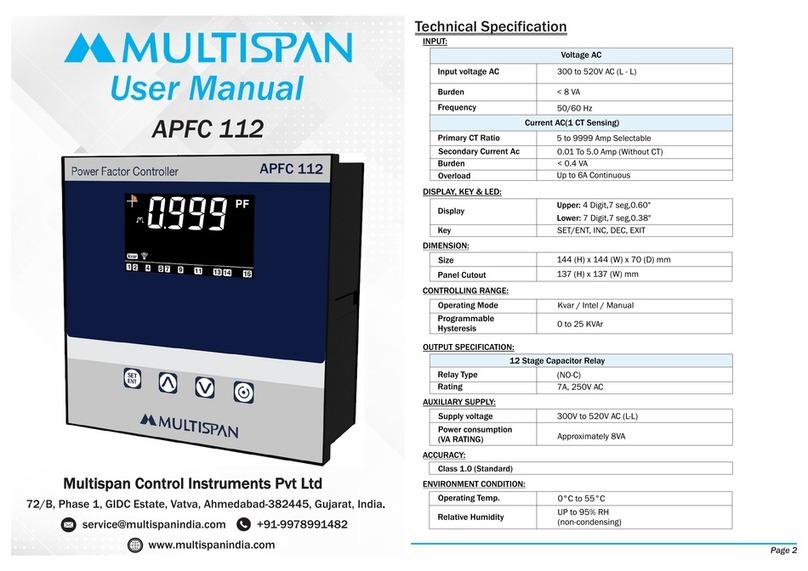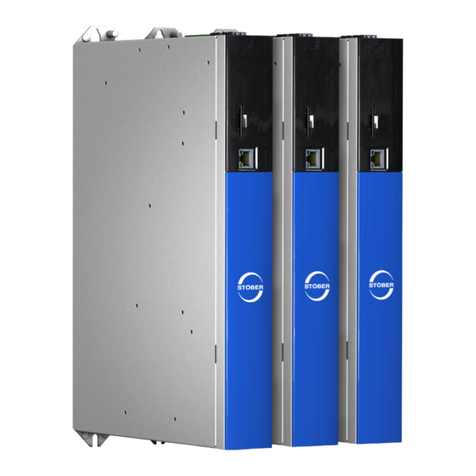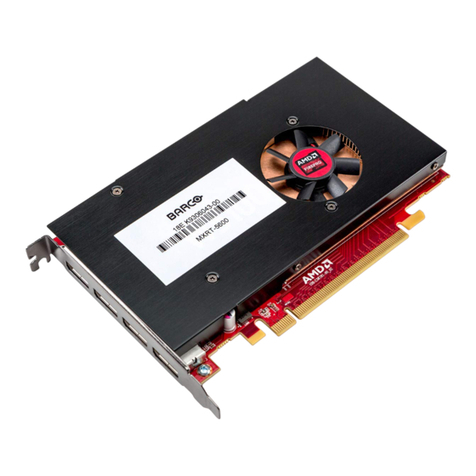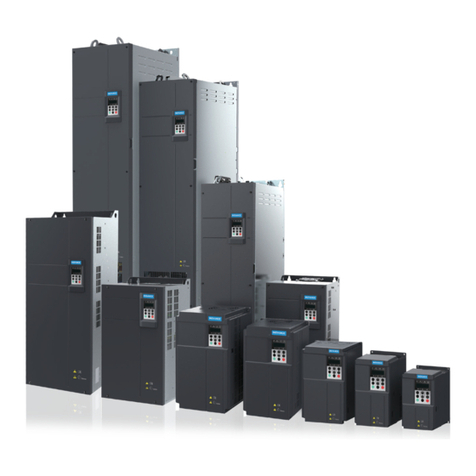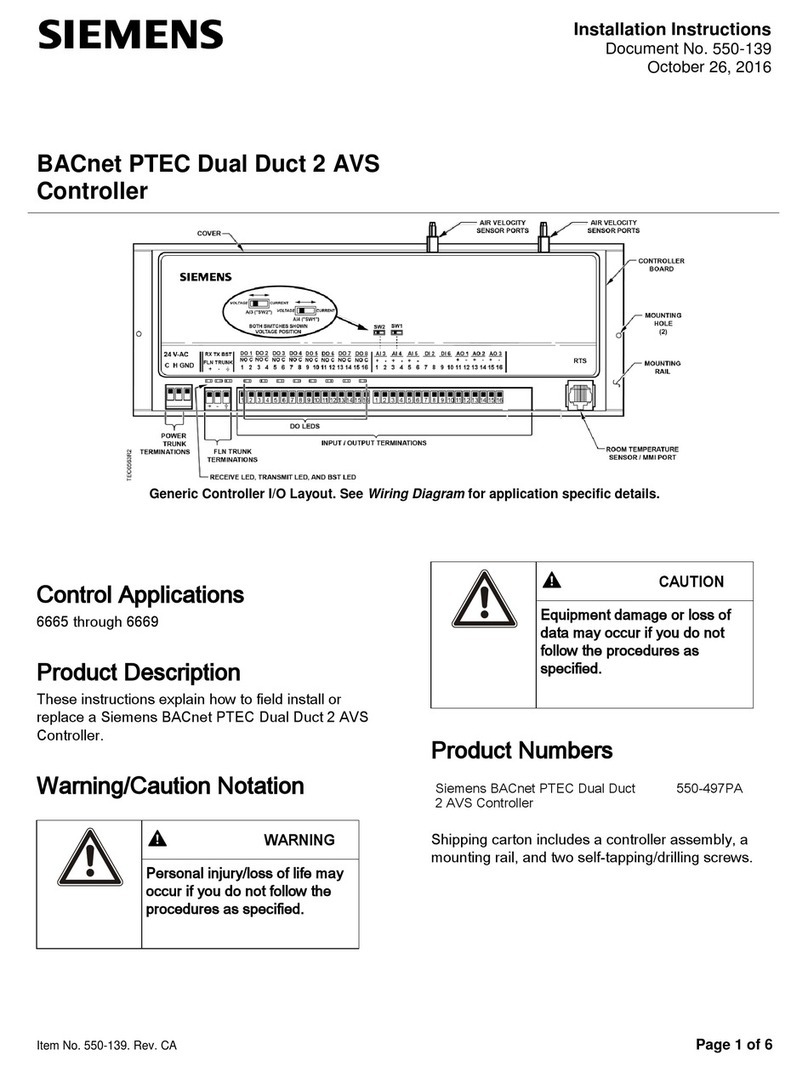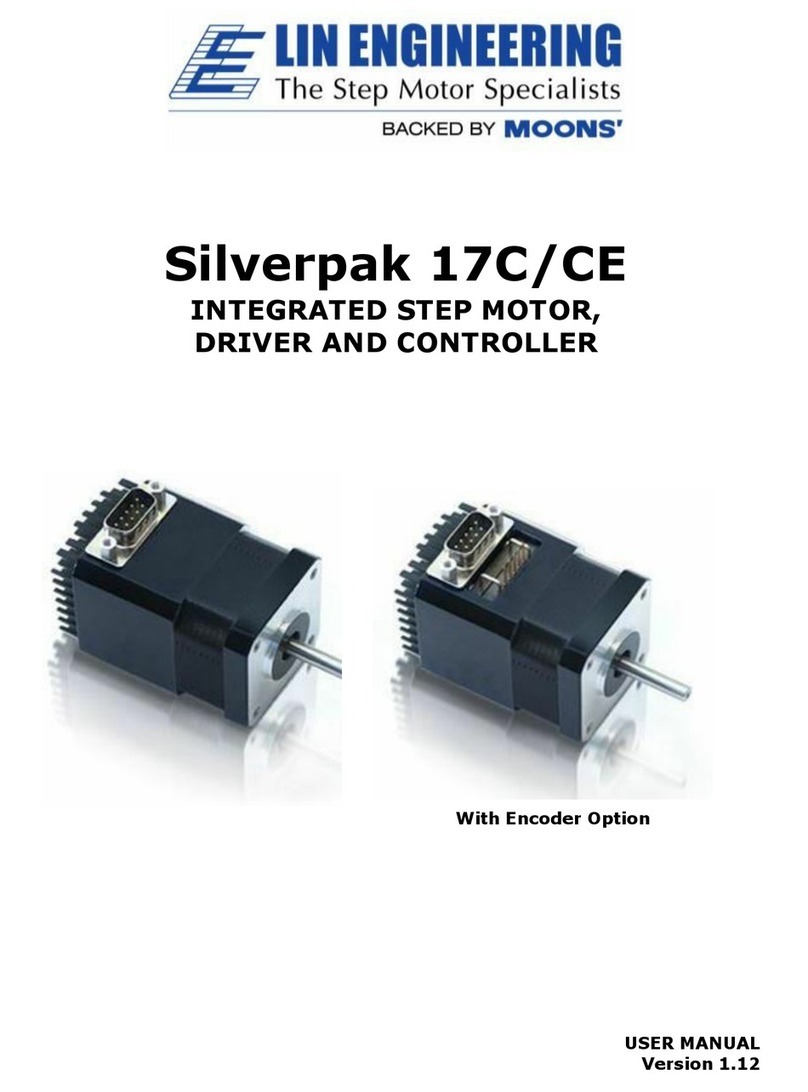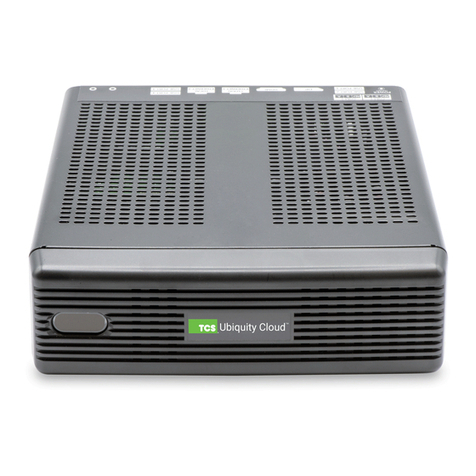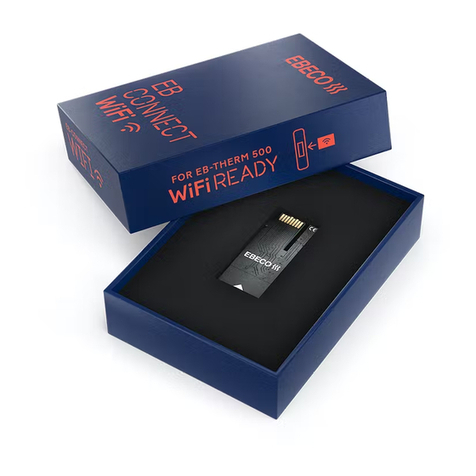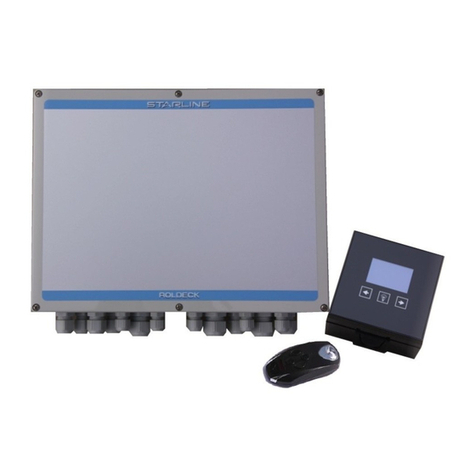Engineered air EngA M-TRAC4 Mounting instructions

A
IOM-33 Dec 16 R4
USER OPERATION
MANUAL
FOR
M-TRAC4
DIRECT FIRED HEATING CONTROLLER
UNIT MODEL NO. _________________
UNIT SERIAL NO. _________________
SERVICED BY: ___________________
TEL. NO: ________________________
CANADIAN
HEAD OFFICE
AND FACTORY
USA
HEAD OFFICE
AND FACTORY
CANADIAN
EASTERN FACTORY
1401 HASTINGS CRES. SE
CALGARY, ALBERTA
T2G 4C8
Ph: (403) 287-2590
Fax: 888-364-2727
32050 W. 83rd STREET
DESOTO, KANSAS
66018
Ph: (913) 583-3181
Fax: (913) 583-1406
1175 TWINNEY DRIVE
NEWMARKET, ONTARIO
L3Y 5V7
Ph: (905) 898-1114
Fax: (905) 898-7244
SALES OFFICES ACROSS CANADA AND USA
Retain instructions with unit and maintain in a legible condition.
Please give model number and serial number when contacting
factory for information and/or parts.
www.engineeredair.com

A M-TRAC4
IOM-33 2of 18 Dec 16 R4
M-TRAC4
The M-TRAC4 has been certified by Intertek (ETL) for use with Engineered Air appliances only.
It has been evaluated to CSA C22.2 No. 24 Temperature-Indicating and Regulating Equipment
and UL 873 UL Standard for Safety Temperature-Indicating and Regulating Equipment. This is a
User Operation Manual and therefore not subject to evaluation.
If any errors or omissions are noted please contact the nearest Engineered Air Technical Service
Department.
To ensure warranty is honored, only qualified personnel should be employed for service and
troubleshooting. If further information is required please contact the nearest Engineered Air
office.
There are two sets of electrical drawings and unit function sheets provided with the appliance.
One set is in an envelope which also contains the Operation, Installation and Maintenance
manual(s). This package is for copying, then should either be returned to the appliance or
stored in a safe place. The other set is attached to the control panel door and should never be
removed.
Please report any omissions to the national service manager.
Warning:
m
Improper installation, adjustment, alteration, service or maintenance can cause
property damage, injury or death. Read the installation, operating and
maintenance instructions thoroughly before installing or servicing this equipment.
Warning:
This unit is connected to high voltages. Electrical shock or death could occur is
instructions are not followed. This equipment contains moving parts that can start
unexpectedly. Injury or death could occur if instructions are not followed. All
work should be performed by a qualified technician. Always disconnect and lock
out power before servicing. DO NOT bypass any interlock or safety switches under
any circumstances.
m
c

A M-TRAC4
IOM-33 3of 18 Dec 16 R4

A M-TRAC4
IOM-33 4of 18 Dec 16 R4
TABLE OF CONTENTS
INTRODUCTION .............................................................................................................................................................5
CONTROLLER RATINGS ..................................................................................................................................................5
CONTROLLER DESCRIPTION...........................................................................................................................................6
TERMINALS ................................................................................................................................................................6
DIP SWITCHES............................................................................................................................................................7
INDICATION AND DIAGNOSTIC LIGHTS......................................................................................................................7
ADJUSTMENT POTS....................................................................................................................................................7
MULTIMETER TEST POINTS............................................................................................................................................8
MAXIMUM DISCHARGE SET POINT LIMIT SETUP (SP LMT) .......................................................................................8
CALCULATED SETPOINT (SPC)....................................................................................................................................8
DISCHARGE TEMPERATURE (DTEMP) ........................................................................................................................8
PROFILE PLATE VELOCITY...........................................................................................................................................9
LOCKOUT RESET.........................................................................................................................................................9
CONTROL .....................................................................................................................................................................10
SYSTEM TIMING.......................................................................................................................................................10
DISCHARGE AIR SETPOINT .......................................................................................................................................10
DISCHARGE AIR SENSOR ..........................................................................................................................................10
LOW LIMIT ...............................................................................................................................................................10
DAMPER CONTROL ..................................................................................................................................................11
BLOWER CONTROL ..................................................................................................................................................11
BURNER CONTROL...................................................................................................................................................11
PROFILE PLATE VELOCITY SENSING SYSTEM............................................................................................................12
TEMPERATURE RESET ..................................................................................................................................................12
MAKE / BREAK THERMOSTAT..................................................................................................................................12
2 –10 Vdc SIGNAL (BMS).........................................................................................................................................12
OPERATION..................................................................................................................................................................13
EXHAUST FAN INTERLOCKING .................................................................................................................................13
LOW FIRE .................................................................................................................................................................13
CALIBRATION ...............................................................................................................................................................14
SETPOINT (SPC)........................................................................................................................................................14
DISCHARGE AIR TEMPERATURE (DTEMP)................................................................................................................14
PROFILE VELOCITY ...................................................................................................................................................15
2-10 VDC RESET SET UP ...........................................................................................................................................15
SERVICE........................................................................................................................................................................15
SERVICE MODE ........................................................................................................................................................15
SETTING HIGH CAPACITY .........................................................................................................................................15
SETPOINT REMOTE WIRING.....................................................................................................................................15
AIR PRESSURE SENSOR ............................................................................................................................................16
INPUT CONTACTS BY OTHERS..................................................................................................................................16
BMS SENSOR LOCATION ..........................................................................................................................................16
VFD FEEDBACK ADJUSTMENT..................................................................................................................................16
M-TRAC4 LOCK OUT DESCRIPTION..........................................................................................................................18
SENSOR TABLE .........................................................................................................................................................18

A M-TRAC4
IOM-33 5of 18 Dec 16 R4
INTRODUCTION
The M-TRAC4 is a discharge air temperature controller of variable volume direct-fired
Engineered Air equipment. The M-TRAC4 maintains the required burner airflow by modulating
the burner profile bypass damper (or return air damper on RE style equipment).
The information used in this manual should be used in conjunction with the unit function
sheet(s) and the HE (or RE) series Installation, Operation, and Maintenance manual.
The M-TRAC4 is designed to control only Engineered Air equipment.
Note: It is necessary that all of the remote wiring and controls be complete and operational
before starting the appliance.
Various upgrades and improvements have been made over time. Always include any suffix
letters and numbers for trouble shooting or replacement. All M-TRAC4 models are backwards
compatible; however some additional wiring may be required.
CONTROLLER RATINGS
Power requirements: 24 Vac, 40 VA.
Contact Rating: 120V 3A inductive
2-10 Vdc input impedance: 2 k
Environment: -40 to 120°F (-40 to 50°C) non-condensing.
Fuse Rating: 1.25 GDC slow-blow

A M-TRAC4
IOM-33 6of 18 Dec 16 R4
CONTROLLER DESCRIPTION
TERMINALS TABLE 1
Terminal
Description
Q1
Input terminal for single discharge sensor
Q2
Input terminal for two discharge sensors wired in series
U
Sensor common
SP
Output from the built in set point POT.
RP
Positive supply for a remote set point POT.
RS
Return from the remote set point POT.
S
Setpoint enable
+ / -
2 to 10 Vdc temperature reset input
H
24 Vac hot
N
24 Vac neutral (ground)
FS
Fan switch input
HS
Heat switch input
LMT
Input from safety limit (high limit)
VN
Neutral for the 120 Vac Main gas valve feedback
VFB 120
Hot for the 120 Vac Main gas valve feedback
FR
Flame relay control
CFR
Flame relay control common
PV1 / PV2
Pilot Valve control contacts
C
Input power supply to feed DM, SA and AL outputs
DM
Damper enable output
SA
Supply blower output
AL
Alarm output or Reverse interlock control output
MX1 / MX2
Maxitrol valve output.
AO
Output to air volume controller.
AFB
Air volume feedback input.
PPA
Burner bypass actuator output.
ASP
Air setpoint (volume) input.
PH
Fixed 10Vdc output (+).
PL
Reference 10Vdc output (-).
OA1 / OA2
Outside air temperature sensor.

A M-TRAC4
IOM-33 7of 18 Dec 16 R4
DIP SWITCHES
The M-TRAC4 options are configured by DIP switch selection and/or wiring connections. DIP
switch settings are noted on the internal wiring diagram, and should not be altered.
TABLE 2
DIP SW
Description
9
Service Mode. Enable to manually control the firing rate.
8
Air Priority Program. See Blower Control.
7
16 Second Pre-purge. Heating will delay on after fan starts.
6
Alarm contact to be used for reverse interlock. See Reverse Interlock.
5
Disable Open Sensor Checking. See Discharge Air Setpoint.
4
Disable Low Limit. See Low Limit.
3
Disable remote reset of failure codes.
2
2-10 Vdc Set Point Reset. See Temperature Reset.
1
VAV application.
INDICATION AND DIAGNOSTIC LIGHTS
There are 5 status lights on the M-TRAC4 labeled A to E. They operate in 4 patterns: an
irregular flash (.. __ .. __ ..), fast flash (…….), slow flash (. . .), or constantly on (_____).
TABLE 3
IRREGULAR
FAST
SLOW
ON
LIGHT
System Lockout
System Lockout
System
Problem
System
Ok
A –GREEN
Wiring Or Flame
Relay Problem
Prepurge Cabinet
Limit Open
Ignition
Attempt
B –RED
Air Flow Or M-TRAC
Problem
Air Velocity Very Low
Air Velocity
Too Low
Air Velocity Too
High
C –RED
Service Mode
Ignition Failure
Heat Switch Open
Burner On
D –RED
Open Discharge
Sensor
Discharge Temp Low
Fan Switch Open
Damper Open
Delay
E –RED
ADJUSTMENT POTS
There are a number of setting and calibration potentiometers (POT’s) located on the face of the
M-TRAC4. Modifications to these should only be performed by experienced and qualified
personnel.

A M-TRAC4
IOM-33 8of 18 Dec 16 R4
TABLE 4
POT
Description
SP LMT
Limits the maximum discharge temperature set point.
CAL DTEMP
Discharge air sensor temperature calibration.
SP CAL
Setpoint dial calibration.
SERVICE POT
Manually sets burner firing rate for service. Located just above the centre.
When the service switch is on, this POT can be used to adjust the
modulating gas valve from low to high fire. When the service DIP switch is
on, light ‘D’ blinks irregularly.
2-10 Vdc
RESET RATIO
Sets the reset temperature range. This adjusts the amount of reset range
the 2-10 Vdc room thermostat will have. This allows an adjustment band
between 5°F and 50°F (3°C and 28°C).
PROFILE
VELOCITY
Allows a narrow adjustment for Profile pressure set point.
SA DAMPER MIN
POS
Adjusts the minimum output to the air volume controller (terminal AO).
MULTIMETER TEST POINTS
The M-TRAC4 has readout test points for discharge air temperature, discharge set point and
profile plate velocity status. Temperature readings are indicated by Vdc referenced to ground.
MAXIMUM DISCHARGE SET POINT LIMIT SETUP (SP LMT)
Regulations, design or authorities having jurisdiction may require limiting the maximum
discharge air temperature the appliance is allowed to reach. This may be set by the
potentiometer SP LMT, which is located below and to the right of the M-TRAC4 discharge set
point knob. Vdc readout = °C / 10. See Table 5.
CALCULATED SETPOINT (SPC)
The SPC measurement point is located just below the M-TRAC4 set point knob. This
temperature is the current operating set point after all applicable temperature resets have
been applied to primary or base set point. Vdc readout = °C / 10. See Table 5.
DISCHARGE TEMPERATURE (DTEMP)
The DTEMP measurement point is located on the top left corner of the M-TRAC. The voltage
reading relates to the actual temperature of the discharge sensor. Vdc readout = °C / 10. See
Table 5.

A M-TRAC4
IOM-33 9of 18 Dec 16 R4
Table 5
Voltage (Vdc)
˚C
˚F
1
10
50
1.5
15
59
2
20
68
2.5
25
77
3
30
86
3.5
35
95
4
40
104
NOTE: Sensor accuracy is diminished at temperatures greater than those noted in table 5.
PROFILE PLATE VELOCITY
The profile plate has been factory set for the airflow shown in the submittal record.
The profile plate air velocity status can be determined by reading the DC volts measured
between the profile measurement point (located close to terminal S) and terminal N. When the
profile velocity is optimum, the reading is 4.8 Vdc at high fire and full speed. 50% volume
should read 3.5 Vdc, and 33% should read 3.3 Vdc.
Note that if the airflow is reduced below safe operating conditions there are delays built into
the M-TRAC4 that will shut off the unit within 45 seconds.
TABLE 6
Test Point Reading
at high fire
Status
Result
Below 0.8 volts
Very low or no airflow
Unit lockout
Between 0.8 and
3.0 volts
Low airflow
If the burner is already off it is disabled. If the
burner is on, variable timed lockout.
Between 3.0 and
5.2 volts
Operating range
Normal
Over 6.0 volts
High airflow
If the burner is already off it is disabled. If the
burner is on, variable timed lockout.
LOCKOUT RESET
To reset the M-TRAC4 from a lockout condition push the “Reset Push Button” located just
above and to the right of the DIP switch block. If the M-TRAC4 loses line power while locked
out, the status codes (reason for the lockout) will be lost. When power is resumed the M-
TRAC4 will remain locked out, with only the green LED flashing irregularly.

A M-TRAC4
IOM-33 10 of 18 Dec 16 R4
CONTROL
SYSTEM TIMING
Blower startup: 54 seconds after terminal FS is energized.
Low Limit bypass: 4.5 minutes from initial startup, 50 seconds nuisance timer.
Trial for ignition: 30 sec.
DISCHARGE AIR SETPOINT
The M-TRAC4 is a discharge air temperature controller with a built in face mounted set point
knob (that is activated by connecting terminal S to SP). Optionally, the M-TRAC4 is available
with a remote set point, with varying set point ranges. When a remote setpoint is provided, the
M-TRAC4 face mounted set point will have no effect.
Additional methods of resetting the discharge air temperature setpoint may be used. Refer to
the unit function and electrical drawing.
DISCHARGE AIR SENSOR
The M-TRAC4 is designed to use either a single or dual discharge sensors, wired in series. Dual
sensors are always used in equipment with temperature rise over 100˚F (55°C) or with dual
fans. In most applications the discharge air sensor(s) is located in the supply blower outlet.
The discharge air sensor also serves as a low limit (or freeze protection) sensor.
The M-TRAC4 automatically checks the discharge air sensor(s). If the M-TRAC4 reads an open
sensor it will disable temperature control and reduce the firing rate to low fire, then shutdown
the appliance. Open sensor checking may be disabled by switching on DIP switch #5.
LOW LIMIT
The M-TRAC4 control is typically configured so that the discharge air temperature sensor also
performs the function of a low limit or freeze stat. If DIP switch 4 is ‘off’ the low limit function
is enabled. If the discharge temperature falls below 40˚F (4°C) the appliance will shut down and
the LED for low discharge temperature will begin flashing. On initial startup the M-TRAC4 will
internally bypass the low limit for 4.5 minutes. After this time, the low limit discharge
temperature must be below the low limit setpoint (40°F / 4°C) for 4 minutes before the
M-TRAC4 will shut the appliance off.
If DIP switch 4 is ‘on’, the low limit safety function is disabled.

A M-TRAC4
IOM-33 11 of 18 Dec 16 R4
DAMPER CONTROL
The inlet damper actuator(s) is enabled through output terminal DM. The M-TRAC4 allows time
for the dampers to open prior to starting the supply blower.
BLOWER CONTROL
The M-TRAC4 uses output terminal SA to control the supply air fan. There are, however, a
number of internal and/or external components that may be required to be functional prior to
starting the blower. Proof of air flow is confirmed by the profile pressure sensor.
In some applications continuous airflow is more important than temperature control. The
M-TRAC4 has two blower control program options. They are referred to as airflow priority, and
comfort priority. See Table 7 for the differences between the two priorities. Priority type is
selected by DIP switch 8.
For the comfort priority program, minimum airflow is defined as 60% of required airflow.
Airflow priority is defined as 40% of required airflow.
TABLE 7
Priority Level
Status
Comfort
Air Flow
Heat switch off.
Low airflow
Lock out in 50 seconds.
Blower will remain on until the
discharge air temperature falls
below 40˚F (4°C).
Flame failure, with
discharge temperature
greater than 40°F (4˚C).
Burner and blower off.
Burner off, blower continues to run.
Heat on, but sensing a high
air velocity condition.
Unit will shutdown after
60 seconds.
Burner will lockout after 60
seconds. Blower will remain on
until the discharge air temperature
falls below 40˚F (4°C).
Heat on, with the high limit
control open.
Unit will shutdown after 4
seconds.
Burner will lockout after 4 seconds.
Blower will remain on until the
discharge air temperature falls
below 40˚F (4°C).
BURNER CONTROL
The M-TRAC4 outputs a 2 to 16 Vdc signal to a Maxitrol valve to control and maintain a defined
discharge air temperature setpoint.

A M-TRAC4
IOM-33 12 of 18 Dec 16 R4
PROFILE PLATE VELOCITY SENSING SYSTEM
The M-TRAC4 has a built in profile pressure sensor to prove and monitor air flow across the
burner. This allows the burner to operate safely and efficiently by proving the airflow is within
proper air velocity limits.
The profile pressure sensor has three non-adjustable air settings: 40, 60 and 120% of normal
airflow. These perform the equivalent function of the high (120%) and low (60%) velocity air
switches while providing an additional very low (40%) velocity for use in process applications,
when providing air is more crucial than temperature control.
The normal profile plate pressure drop is 0.48”w.c.
TEMPERATURE RESET
MAKE / BREAK THERMOSTAT
The set point can be configured for two-level discharge air temperature control, initiated by a
override contact or space mounted, single stage thermostat, with the second (upper) level
adjustable from 75˚(24°C) to 160˚F (71°C) by the SP LMT POT.
2 –10 Vdc SIGNAL (BMS)
The set point can be adjusted linearly upwards from 5°F to 50 °F (3°C to 28°C) from a 2-10 Vdc
BMS input on terminals - and +. When equipped with a 2 to 10 Vdc room thermostat, this
option becomes a linear room reset. The discharge set point dial, either face mounted or
remote mounted, is the minimum set point. The maximum reset amount is adjusted by the 2-
10VDC RESET RATIO POT located beside terminals RS and RP.
RESET EXAMPLE
SP LMT set at 95˚F, Dial set point set at 50˚F.
2-10 Vdc reset ratio POT adjusted to give 30˚F reset at 10 Vdc.
The resulting control will be:
At 0-2 Vdc = 50˚F discharge
At 6 Vdc = is ½ of the reset authority. Half of 30˚F equals 15˚F, therefore the discharge setpoint
will be at 65˚F (50° + 15° = 65°). At 10 Vdc = full reset. Discharge will be at 50° + 30° = 80˚F.
This will not be limited by the SP LMT (at 95°F), unless the setpoint dial is turned up more than
15°F.

A M-TRAC4
IOM-33 13 of 18 Dec 16 R4
OPERATION
EXHAUST FAN INTERLOCKING
There are a number of different exhaust interlocking options available. Always refer to the
wiring diagram and unit function sheet to determine the exact type of interlocking used.
The AL output contact may be switched from an alarm output to a exhaust fan enable output
contact for control of reverse interlock control systems (DIP sw #6). In this mode terminal AL
will close on proof of supply air flow.
LOW FIRE
The M-TRAC4 low fire is set at the modulating valve. With the air flow at maximum and the
output to the Maxitrol modulating valve at 0 Vdc, low fire should be set to just ensure a
continuous and stable flame exists along the entire length of the burner.
Adjust the low fire regulator on M, ES and MR Maxitrol modulating valves to minimum (fully
counter-clockwise) and locked in place by the locking cap. Locate the low fire bypass
adjustment on the valve and turn to set minimum fire. Turning the bypass adjustment
clockwise will reduce the low fire.

A M-TRAC4
IOM-33 14 of 18 Dec 16 R4
CALIBRATION
While the burner and M-TRAC4 is factory tested and calibrated, field conditions may affect
airflow and sensor readings.
After making any calibration adjustment, it may take a few minutes for the M-TRAC4 to reflect
the changes. After this time, turn the appliance off for a few seconds, then back on. Re-
confirm the calibration.
SETPOINT (SPC)
Check the wiring diagram to determine if the M-TRAC4 is using the face mounted setpoint dial
or an optional remote mounted setpoint dial. The most commonly used remote control panel
includes fan and heat on/off switches and a setpoint dial. A jumper will be installed across
terminals S and SP if the M-TRAC4 is using its built in setpoint dial.
1. Disable any external temperature resets (DIP switch #2 off) or lower the room
thermostat settings so there is no call for additional heat.
2. Use a voltmeter to measure the Vdc output on the SPC measurement point.
3. Compare to the Setpoint dial and adjust the SP CAL POT (located near the face mounted
setpoint dial) so they match (1 Vdc = 10°C).
4. Turn DIP switch 1 on, or return the room thermostat to its normal position.
Note: If the adjustments have no effect on the discharge temperature, the set point may be
under the authority of the maximum set point limiting POT (SP LMT).
DISCHARGE AIR TEMPERATURE (DTEMP)
The discharge sensor must be located so that its temperature remains stable. Due to the
nature of direct fired appliance, the air temperature leaving the supply blower is often very
stratified. It is important to understand that the supply blower does not significantly mix the
air. As well, the stratification pattern will change with different firing rates, wind conditions,
ducting and blower configurations.
Field conditions may result in differences between the sensed temperature and the actual
temperature. Adjusting the location of the discharge sensor a few inches will often correct
temperature differences. If a section of duct is connected to the discharge opening, the sensor
may be moved downstream up to 10 ft. (3 meters). Moving the sensor too far downstream
may result in sensing lag, which could compound control error.
1. Accurately measure the temperature at the discharge air sensor.
2. Compare the temperature to the DTEMP test point voltmeter reading.
3. Match the readings by adjusting the CAL DTEMP POT (located near terminal Q1).

A M-TRAC4
IOM-33 15 of 18 Dec 16 R4
PROFILE VELOCITY
Profile velocity test point readings outside the 3.0 - 6.0 Vdc range generally indicate improper
airflow through the burner. Before attempting to adjust the profile velocity ensure the heater
is operating at the required nameplate air volume.
The Profile Velocity POT is typically set to the ‘12’ o’clock position. Outside air temperature will
affect the pressure drop across the burner.
2-10 VDC RESET SET UP
1. The 2-10 VDC RESET RATIO POT is located beside terminal RS.
2. Turn off DIP switch 1 and turn the discharge set point knob (face mounted or remote) to
the minimum required set point.
3. Set the voltage across terminals + and –to maximum (10 volts).
4. Calculate the maximum required discharge temperature (°C) and divide by 10.
5. Turn on DIP switch 1 and adjust 2-10 Vdc reset POT ratio until the SPC voltage is equal to
the number calculated in the above step.
6. Adjust SP LMT until the voltage reading is the same as was recorded in step 5.
SERVICE
SERVICE MODE
Placing the M-TRAC4 into service mode allows for direct control of the burner firing rate. Once
the burner has started, the M-TRAC4 can be placed into the service mode by turning on DIP
switch #9. The service POT, located above the reset push button, will control the position of
the modulating valve to any position from low to high fire.
Note: the service mode does not bypass any safeties, heat or fan switches.
SETTING HIGH CAPACITY
Ensuring that operation at high capacity is correct is critical to the operation of the appliance at
all other firing rates.
Set the M-TRAC4 and any related controls to high capacity. Ensure the bypass damper is fully
open, and approximately 9 Vdc is measured at terminal PPA, and the profile pressure test
points read 4.8 Vdc.
SETPOINT REMOTE WIRING
Impedance from long wiring runs may cause the setpoint to be out of calibration. Refer to the
setpoint calibration section if adjustment is required.

A M-TRAC4
IOM-33 16 of 18 Dec 16 R4
AIR PRESSURE SENSOR
The M-TRAC4 has an internally mounted air pressure sensor. Do not blow onto the pressure
ports –too much air pressure will damage it. The ports are fragile and can easily break.
During initial startup, the space the appliance is feeding may be under negative or positive
pressure. To accurately check the M-TRAC4 pressure sensor, remove the sensing tubes from
the M-TRAC4, while the fan is on, and the reading should be 0 Vdc.
The M-TRAC4 air pressure monitoring system performs a time weighted calculation based on
severity of change, to provide some protection against nuisance lock outs from various sources,
such as wind gusts. Once the airflow has stabilized, the timer is reset.
Before making any modifications to the profile opening contact Engineered Air.
INPUT CONTACTS BY OTHERS
Input contacts, such as HS and FS must use mechanical relay (dry) input contacts. The use of
solid state relay’s (SSR’s) may cause the M-TRAC4 to malfunction due to reverse leakage current
when ‘open’.
BMS SENSOR LOCATION
If there is a BMS sensor located in the discharge duct, that sensor must be mounted within ½
inch of the Engineered Air sensor.
Note: BMS (Building Management System) discharge air temperatures should never be used to
reset the temperature of the heater. Only use space or room mounted sensors.
VFD FEEDBACK ADJUSTMENT
Factory setting of the variable frequency drive feedback cannot anticipate every eventuality
after the appliance has been installed in the field. Nuisance temperature over/under shooting
and limit failures at mid and low firing rates can often be attributed to the incorrect setting of
the VFD feedback. Field tuning will be required on all equipment when the VFD is supplied and
installed by others.
The feedback voltage from the VFD to terminal AFB should be a fair representation of the
actual air volume output to AO terminal. When using a VFD, the output signal feeding into AFB
should provide 10 VDC at high volume, 5 VDC at 50% and 3.3 VDC at 33%. The P11 pot sets the
starting point of the internal temperature control reset curve. (This is the reset curve that
collects signal input from OA sensor, AFB feedback and DA sensor to best control the
modulating gas valve due to an equally proportional rise in the total temperature rise. At half
the volume the heat rise is doubled)

A M-TRAC4
IOM-33 17 of 18 Dec 16 R4
Ensure that the AFB terminal is receiving proper signal as mentioned above, then switch the
speed reference signal to the lowest as per the unit function (typically 33% or 50%). It should
be adjusted such that when the VFD is at minimum volume, the voltage to the second jumper
from the P11 pot should be at minimum. Carefully connect a DC voltmeter from the second
jumper to ground. While watching the meter, gradually turn pot P11 just until the voltage stops
falling. Do not set past this point.
This adjustment ensures that the internal temperature control reset curve starts just as the VFD
begins to ramp up. The internal reset signal will be at maximum when the AFB voltage has
increased by 6 VDC greater than the minimum volume voltage. If the minimum input voltage is
greater than 4 VDC the amount of the internal temperature reset is reduced.
Ensure that the spring activated low fire adjustment on the Maxitrol modulating valve is at
minimun turned fully counter clockwise and locked in place by the locking cap. This is because
the MTRAC-4.3C.4 has 2 to 16 VDC on MX1 and MX2.
VOLTAGE READOUT

A M-TRAC4
IOM-33 18 of 18 Dec 16 R4
M-TRAC4 LOCK OUT DESCRIPTION
Table 8
LED Code
Reasons
B Irregular
Faulty flame relay or wiring error. Ignition control and safety shut off valve
should be off (FR and CFR contact ‘open’, but receiving power to VFB120
indicating valve is still on.
Faulty flame relay or wiring error. FR and CFR contacts closes, but feedback
from safety shut off valve to VFB120 happening too fast.
B Slow
High limit open.
C Fast
Very low air flow. Sensed air flow is below 40%.
C Slow
Low air flow. Sensed air flow is below 60%.
C On
High air flow. Sensed air flow is over 120%.
D Fast
Ignition failure.
E Irregular
Open discharge air sensor. Sensor resistance should not exceed 1940, or 3450 Ω
for dual sensors.
E Fast
Low limit. Discharge temperature has fallen below 40°F (4°C).
SENSOR TABLE
Sensor Resistance Chart for TE600EA3.
Table 9
˚C
˚F
Resistance Ω
˚C
˚F
Resistance Ω
˚C
˚F
Resistance Ω
-40
-40
602
4.4
40
881
48.9
120
1234
-34.4
-30
633
10
50
921
54.4
130
1269
-28.9
-20
665
15.6
60
963
60
140
1333
-23.3
-10
698
21.1
70
1005
65.6
150
1365
-17.8
0
732
26.7
80
1048
71.1
160
1437
-12.2
10
768
32.2
90
1092
76.7
170
1491
-6.6
20
804
37.8
100
1139
82.2
180
1546
-1.1
30
842
43.3
110
1186
87.8
190
1602
Note: Reference resistance is 1035 ohms at 77˚F. Resistance tolerances are ±0.05 to 0.15% at 77˚F.
Table of contents
Other Engineered air Controllers manuals
